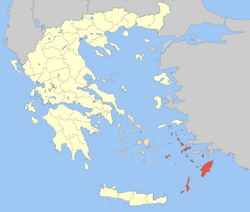Italian Dodecanese
| Italian Islands of the Aegean | ||||||||||||
|
Isole italiane dell'Egeo Ἰταλικαὶ Νῆσοι Αἰγαίου Πελάγους |
||||||||||||
| Intermediate status between colony and integral part of Italy | ||||||||||||
|
||||||||||||
|
||||||||||||
|
Motto Foedere et Religione Tenemur "We are held together by Pact and Religion" |
||||||||||||
|
Anthem Marcia Reale d'Ordinanza "Royal March of Ordinance"a |
||||||||||||
| Capital | Rhodes | |||||||||||
| Languages | Greek, Italian, Turkish | |||||||||||
| Religion |
Greek Orthodox, Roman Catholic |
|||||||||||
| Political structure | Possedimento | |||||||||||
| Military Commander (until 1922) Governor (1922–43) | ||||||||||||
| • | 1912–13 | Giovanni Battista Ameglio (first commander) | ||||||||||
| • | 1922–36 | Mario Lago (first governor) | ||||||||||
| • | 1936-40 | Cesare Maria De Vecchi | ||||||||||
| • | 1940–41 | Ettore Bastico | ||||||||||
| • | 1941–43 | Inigo Campioni | ||||||||||
| Historical era | Interwar / WWII | |||||||||||
| • | Italo-Turkish War | 27 April 1912 | ||||||||||
| • | Armistice of Cassibile & Dodecanese Campaign | September–November 1943 | ||||||||||
| Area | ||||||||||||
| • | 1936 | 2,668 km² (1,030 sq mi) | ||||||||||
| Population | ||||||||||||
| • | 1936 est. | 132,289 | ||||||||||
| Density | 49.6 /km² (128.4 /sq mi) | |||||||||||
| Currency | Italian lira | |||||||||||
|
||||||||||||
| a: After the Fascist takeover in 1922, unofficial anthem was Giovinezza ("Youth"). | ||||||||||||
The Italian Islands of the Aegean (Italian: Isole italiane dell'Egeo, Greek: Ἰταλικαὶ Νῆσοι Αἰγαίου Πελάγους) were a group of twelve major islands (the Dodecanese) in the southeastern Aegean Sea, which — together with the surrounding islets — were ruled by the Kingdom of Italy from 1912 to 1943.
The Dodecanese, except Kastellorizo, were occupied by Italy during the Italo-Turkish War of 1912. Italy had agreed to return the islands to the Ottoman Empire according to the Treaty of Ouchy in 1912; however the vagueness of the text allowed a provisional Italian administration of the islands, and Turkey eventually renounced all claims on the Dodecanese with Article 15 of the Treaty of Lausanne in 1923.
The provisional Italian regime on the islands—titled "Rhodes and the Dodecanese" (Rodi e Dodecanese)—was originally in the hands of military governors, until the appointment on 7 August 1920 of Count Carlo Senni as the Viceroy of the Dodecanese (Reggente del Dodecaneso). Following the end of World War I, Italy agreed twice, in the Venizelos–Tittoni agreement of 1919 and the Treaty of Sèvres in 1920, to cede the islands to Greece except for Rhodes, which would enjoy extensive autonomy. Due to the Greek embroilment and defeat in the Greco-Turkish War of 1919–22, these agreements were never implemented.
Kastellorizo was temporarily occupied by France in 1915 and came under Italian control in 1921. The Dodecanese islands were formally annexed by Fascist Italy, as the Possedimenti Italiani dell'Egeo in 1923.
...
Wikipedia



